Zinc Vanadate (Zn3V2O8) Immobilized Multiwall Carbon Nanotube (MWCNT) Heterojunction as an Efficient Photocatalyst for Visible Light Driven Hydrogen Production
Abstract
:1. Introduction
2. Results and Discussion
2.1. Material Characterization Studies
2.2. Hydrogen Production Experiments
2.2.1. Selection of Sacrificial Reagent
2.2.2. Effects of Various Reaction Parameters
2.3. Reusability Experiments
2.4. Mechanism of H2 Production
3. Materials and Methods
3.1. Reagents and Chemicals
3.2. Synthesis of ZV and ZV@MWCNT
3.3. Instrumentation Used
3.4. Photocatalytic Hydrogen Production Experiments
4. Conclusions
Author Contributions
Funding
Institutional Review Board Statement
Informed Consent Statement
Data Availability Statement
Acknowledgments
Conflicts of Interest
Sample Availability
References
- Lin, B.; Li, H.; An, H.; Hao, W.; Wei, J.J.; Dai, Y.; Ma, C.; Yang, G. Preparation of 2D/2D g-C3N4 Nanosheet@ZnIn2S4 Nanoleaf Heterojunctions with Well-Designed High-Speed Charge Transfer Nanochannels towards High-Efficiency Photocatalytic Hydrogen Evolution. Appl. Catal. B 2018, 220, 542–552. [Google Scholar] [CrossRef]
- Li, Y.; Zhang, P.; Wan, D.; Xue, C.; Zhao, J.; Shao, G. Direct Evidence of 2D/1D Heterojunction Enhancement on Photocatalytic Activity through Assembling MoS2 Nanosheets onto Super-Long TiO2 Nanofibers. Appl. Surf. Sci. 2020, 504, 144361. [Google Scholar] [CrossRef]
- Ding, M.; Xiao, R.; Zhao, C.; Bukhvalov, D.; Chen, Z.; Xu, H.; Tang, H.; Xu, J.; Yang, X. Evidencing Interfacial Charge Transfer in 2D CdS/2D MXene Schottky Heterojunctions toward High-Efficiency Photocatalytic Hydrogen Production. Sol. RRL 2021, 5, 2000414. [Google Scholar] [CrossRef]
- Yang, M.; Jin, Z.; Wang, C.; Cao, X.; Wang, X.; Ma, H.; Pang, H.; Tan, L.; Yang, G. Fe Foam-Supported FeS2-MoS2Electrocatalyst for N2Reduction under Ambient Conditions. ACS Appl. Mater. Interfaces 2021, 13, 55040–55050. [Google Scholar] [CrossRef] [PubMed]
- Wang, C.; Sui, G.; Guo, D.; Li, J.; Ma, X.; Zhuang, Y.; Chai, D.F. Oxygen Vacancies-Rich NiCo2O4-4x Nanowires Assembled on Porous Carbon Derived from Cigarette Ash: A Competitive Candidate for Hydrogen Evolution Reaction and Supercapacitor. J. Energy Storage 2022, 50, 104280. [Google Scholar] [CrossRef]
- Wang, C.; Sui, G.; Guo, D.; Li, J.; Luo, Z.; Chai, D.F.; Qi, M. A Novel Self-Activation Strategy for Designing Oxygen Vacancies-Rich Nickel Ferrite and Cobalt Ferrite Microspheres with Large Specific Surface Area for Overall Water Splitting. Int. J. Hydrog. Energy 2022, 47, 24343–24357. [Google Scholar] [CrossRef]
- Tie, S.F.; Tan, C.W. A Review of Energy Sources and Energy Management System in Electric Vehicles. Renew. Sustain. Energy Rev. 2013, 20, 82–102. [Google Scholar] [CrossRef]
- Song, M.; Wu, Y.; Zhao, Y.; Du, C.; Su, Y. Structural Insight on Defect-Rich Tin Oxide for Smart Band Alignment Engineering and Tunable Visible-Light-Driven Hydrogen Evolution. Inorg. Chem. 2020, 59, 3181–3192. [Google Scholar] [CrossRef]
- Wu, Y.; Wang, H.; Tu, W.; Wu, S.; Chew, J.W. Effects of Composition Faults in Ternary Metal Chalcogenides (ZnxIn2S3+x, X = 1–5) Layered Crystals for Visible-Light-Driven Catalytic Hydrogen Generation and Carbon Dioxide Reduction. Appl. Catal. B 2019, 256, 117810. [Google Scholar] [CrossRef]
- Yavuz, C.; Erten-Ela, S. Solar Light-Responsive α-Fe2O3/CdS/g-C3N4 Ternary Photocatalyst for Photocatalytic Hydrogen Production and Photodegradation of Methylene Blue. J. Alloy. Compd. 2022, 908, 164584. [Google Scholar] [CrossRef]
- Huang, G.; Ye, W.; Lv, C.; Butenko, D.S.; Yang, C.; Zhang, G.; Lu, P.; Xu, Y.; Zhang, S.; Wang, H.; et al. Hierarchical Red Phosphorus Incorporated TiO2 Hollow Sphere Heterojunctions toward Superior Photocatalytic Hydrogen Production. J. Mater. Sci. Technol. 2022, 108, 18–25. [Google Scholar] [CrossRef]
- Wang, Y.; Liu, C.; Kong, C.; Zhang, F. Defect MoS2 and Ti3C2 Nanosheets Co-Assisted CdS to Enhance Visible-Light Driven Photocatalytic Hydrogen Production. Colloids Surf. A Physicochem. Eng. Asp. 2022, 652, 129746. [Google Scholar] [CrossRef]
- Imran, M.; bin Yousaf, A.; Farooq, M.; Kasak, P. Enhancement of Visible Light-Driven Hydrogen Production over Zinc Cadmium Sulfide Nanoparticles Anchored on BiVO4 Nanorods. Int. J. Hydrog. Energy 2022, 47, 8327–8337. [Google Scholar] [CrossRef]
- Yao, H.; Jin, G.; Sui, G.; Li, J.; Guo, D.; Liang, S.; Luo, Z.; Xu, R.; Wang, C.; Tang, J. ZIF-67-Derived ZnIn2S4/NiCoP Z-Scheme Heterojunctions for Enhanced Visible-Light-Driven Photocatalytic Hydrogen Production. Colloids Surf. A Physicochem. Eng. Asp. 2022, 653, 129991. [Google Scholar] [CrossRef]
- Naghmash, M.A.; Ibrahim, M.M. Chemical Hydrogen Generation for Catalyzed Reduction of Organic Pollutants Using Highly Active MoCu Oxysulfides: Influence of Preparation Method and Hydrothermal Time. Mater. Chem. Phys. 2022, 283, 126036. [Google Scholar] [CrossRef]
- Gultom, N.S.; Abdullah, H.; Kuo, D.H. Phase Transformation of Bimetal Zinc Nickel Oxide to Oxysulfide Photocatalyst with Its Exceptional Performance to Evolve Hydrogen. Appl. Catal. B 2020, 272, 118985. [Google Scholar] [CrossRef]
- Bai, Z.; Li, S.; Fu, J.; Zhang, Q.; Chang, F.; Yang, L.; Lu, J.; Chen, Z. Metal-Organic Framework-Derived Nickel Cobalt Oxysulfide Nanocages as Trifunctional Electrocatalysts for High Efficiency Power to Hydrogen. Nano Energy 2019, 58, 680–686. [Google Scholar] [CrossRef]
- Sisay, G.; Abdullah, H.; Kuo, D.H.; Lakew, W.; Shuwanto, H.; Fentie, S. Zn-Ce-Ga Trimetal Oxysulfide as a Dual-Functional Catalyst: Hydrogen Evolution and Hydrogenation Reactions in a Mild Condition. Appl. Surf. Sci. 2021, 563, 150383. [Google Scholar] [CrossRef]
- Bhuiyan, T.H.; Rahman, A.; Rahman, A.; Sultana, R.; Mostafa, R.; Tania, A.H.; Sarker, A.R. Synthesis and Characterization of High-Quality Cobalt Vanadate Crystals and Their Applications in Lithium-Ion Batteries. Cogent Phys. 2016, 3, 1265778. [Google Scholar] [CrossRef]
- Zhu, Y.; Xu, W.; Zhang, H.; Wang, W.; Xu, S.; Song, H. Inhibited Long-Scale Energy Transfer in Dysprosium Doped Yttrium Vanadate Inverse Opal. J. Phys. Chem. C 2012, 116, 2297–2302. [Google Scholar] [CrossRef]
- Guo, H.; Guo, D.; Zheng, Z.; Wen, W.; Chen, J. Hydrothermal Synthesis and Visible Light Photocatalytic Activities of Zn3(VO4)2 Nanorods. J. Mater. Res. 2014, 29, 2934–2941. [Google Scholar] [CrossRef]
- Wang, M.; Shi, Y.; Jiang, G. 3D Hierarchical Zn3(OH)2V2O7·2H2O and Zn3(VO4)2 Microspheres: Synthesis, Characterization and Photoluminescence. Mater. Res. Bull. 2012, 47, 18–23. [Google Scholar] [CrossRef]
- Tahir, M.B.; Nawaz, T.; Sagir, M.; Alzaid, M.; Alrobei, H.; Shahzad, K.; Ali, A.M.; Muhammad, S. Functionalized Role of Highly Porous Activated Carbon in Bismuth Vanadate Nanomaterials for Boosted Photocatalytic Hydrogen Evolution and Synchronous Activity in Water. Int. J. Hydrog. Energy 2021, 46, 39778–39785. [Google Scholar] [CrossRef]
- Zhang, L.; Jin, Z.; Ma, X.; Zhang, Y.; Wang, H. Properties of Iron Vanadate over CdS Nanorods for Efficient Photocatalytic Hydrogen Production. New J. Chem. 2019, 43, 3609–3618. [Google Scholar] [CrossRef]
- Iqbal, T.; Hassan, A.; Ijaz, M.; Salim, M.; Farooq, M.; Zafar, M.; Tahir, M.B. Chromium Incorporated Copper Vanadate Nano-Materials for Hydrogen Evolution by Water Splitting. Appl. Nanosci. 2021, 11, 1661–1671. [Google Scholar] [CrossRef]
- Seabold, J.A.; Neale, N.R. ChemInform Abstract: All First Row Transition Metal Oxide Photoanode for Water Splitting Based on Cu3V2O8. ChemInform 2015, 46, 1005–1013. [Google Scholar] [CrossRef]
- Yan, Y.; Yu, Y.; Wu, D.; Yang, Y.; Cao, Y. TiO2/Vanadate (Sr10V6O25, Ni3V2O8, Zn2V2O7) Heterostructured Photocatalysts with Enhanced Photocatalytic Activity for Photoreduction of CO2 into CH4. Nanoscale 2015, 8, 949–958. [Google Scholar] [CrossRef]
- Woan, K.; Pyrgiotakis, G.; Sigmund, W. Photocatalytic Carbon-Nanotube–TiO2 Composites. Adv. Mater. 2009, 21, 2233–2239. [Google Scholar] [CrossRef]
- Kongkanand, A.; Domínguez, R.M.; Kamat, P.v. Single Wall Carbon Nanotube Scaffolds for Photoelectrochemical Solar Cells. Capture and Transport of Photogenerated Electrons. Nano Lett. 2007, 7, 676–680. [Google Scholar] [CrossRef]
- Farhadian, M.; Sangpour, P.; Hosseinzadeh, G. Preparation and Photocatalytic Activity of WO3–MWCNT Nanocomposite for Degradation of Naphthalene under Visible Light Irradiation. RSC Adv. 2016, 6, 39063–39073. [Google Scholar] [CrossRef]
- Rojas, J.v.; Toro-Gonzalez, M.; Molina-Higgins, M.C.; Castano, C.E. Facile Radiolytic Synthesis of Ruthenium Nanoparticles on Graphene Oxide and Carbon Nanotubes. Mater. Sci. Eng. B 2016, 205, 28–35. [Google Scholar] [CrossRef]
- Ronde, H.; Blasse, G. The Nature of the Electronic Transitions of the Vanadate Group. J. Inorg. Nucl. Chem. 1978, 40, 215–219. [Google Scholar] [CrossRef]
- Min, X.; Huang, Z.; Fang, M.; Liu, Y.; Tang, C.; Wu, X. Luminescence Properties of Self-Activated M3(VO4)2 (M = Mg, Ca, Sr, and Ba) Phosphors Synthesized by Solid-State Reaction Method. J. Nanosci. Nanotechnol. 2016, 16, 3684–3689. [Google Scholar] [CrossRef] [PubMed]
- Vadivel, S.; Naveen, A.N.; Theerthagiri, J.; Madhavan, J.; Santhoshini Priya, T.; Balasubramanian, N. Solvothermal Synthesis of BiPO4 Nanorods/MWCNT (1D-1D) Composite for Photocatalyst and Supercapacitor Applications. Ceram. Int. 2016, 42, 14196–14205. [Google Scholar] [CrossRef]
- Li, X.; Hao, C.; Tang, B.; Wang, Y.; Liu, M.; Wang, Y.; Zhu, Y.; Lu, C.; Tang, Z. Supercapacitor Electrode Materials with Hierarchically Structured Pores from Carbonization of MWCNTs and ZIF-8 Composites. Nanoscale 2017, 9, 2178–2187. [Google Scholar] [CrossRef]
- Van Hoa, N.; Quyen, T.T.H.; Nghia, N.H.; van Hieu, N.; Shim, J.J. In Situ Growth of Flower-like V2O5 Arrays on Graphene@nickel Foam as High-Performance Electrode for Supercapacitors. J. Alloy. Compd. 2017, 702, 693–699. [Google Scholar] [CrossRef]
- Sambandam, B.; Michael, R.J.V.; Manoharan, P.T. Oxygen Vacancies and Intense Luminescence in Manganese Loaded Zno Microflowers for Visible Light Water Splitting. Nanoscale 2015, 7, 13935–13942. [Google Scholar] [CrossRef]
- Bai, J.; Li, X.; Liu, G.; Qian, Y.; Xiong, S. Unusual Formation of ZnCo2O4 3D Hierarchical Twin Microspheres as a High-Rate and Ultralong-Life Lithium-Ion Battery Anode Material. Adv. Funct. Mater. 2014, 24, 3012–3020. [Google Scholar] [CrossRef]
- Chang, C.J.; Lin, Y.G.; Weng, H.T.; Wei, Y.H. Photocatalytic Hydrogen Production from Glycerol Solution at Room Temperature by ZnO-ZnS/Graphene Photocatalysts. Appl. Surf. Sci. 2018, 451, 198–206. [Google Scholar] [CrossRef]
- Manfro, R.L.; da Costa, A.F.; Ribeiro, N.F.P.; Souza, M.M.V.M. Hydrogen Production by Aqueous-Phase Reforming of Glycerol over Nickel Catalysts Supported on CeO2. Fuel Process. Technol. 2011, 92, 330–335. [Google Scholar] [CrossRef]
- Vaiano, V.; Lara, M.A.; Iervolino, G.; Matarangolo, M.; Navio, J.A.; Hidalgo, M.C. Photocatalytic H2 Production from Glycerol Aqueous Solutions over Fluorinated Pt-TiO2 with High {001} Facet Exposure. J. Photochem. Photobiol. A Chem. 2018, 365, 52–59. [Google Scholar] [CrossRef]
- Vaiano, V.; Iervolino, G.; Sannino, D.; Rizzo, L.; Sarno, G.; Farina, A. Enhanced Photocatalytic Oxidation of Arsenite to Arsenate in Water Solutions by a New Catalyst Based on MoOx Supported on TiO2. Appl. Catal. B 2014, 160–161, 247–253. [Google Scholar] [CrossRef]
- Vaiano, V.; Iervolino, G. Photocatalytic Hydrogen Production from Glycerol Aqueous Solution Using Cu-Doped ZnO under Visible Light Irradiation. Appl. Sci. 2019, 9, 2741. [Google Scholar] [CrossRef] [Green Version]
- Chang, C.J.; Chu, K.W.; Hsu, M.H.; Chen, C.Y. Ni-Doped ZnS Decorated Graphene Composites with Enhanced Photocatalytic Hydrogen-Production Performance. Int. J. Hydrogen Energy 2015, 40, 14498–14506. [Google Scholar] [CrossRef]
- Kondarides, D.I.; Daskalaki, V.M.; Patsoura, A.; Verykios, X.E. Hydrogen Production by Photo-Induced Reforming of Biomass Components and Derivatives at Ambient Conditions. Catal. Lett. 2008, 122, 26–32. [Google Scholar] [CrossRef]
- Wang, Y.; Liu, T.; Tian, W.; Zhang, Y.; Shan, P.; Chen, Y.; Wei, W.; Yuan, H.; Cui, H. Mechanism for Hydrogen Evolution from Water Splitting Based on a MoS2/WSe2 Heterojunction Photocatalyst: A First-Principle Study. RSC Adv. 2020, 10, 41127–41136. [Google Scholar] [CrossRef]
- Vijayakumar, S.; Lee, S.H.; Ryu, K.S. Synthesis of Zn3V2O8 Nanoplatelets for Lithium-Ion Battery and Supercapacitor Applications. RSC Adv. 2015, 5, 91822–91828. [Google Scholar] [CrossRef]
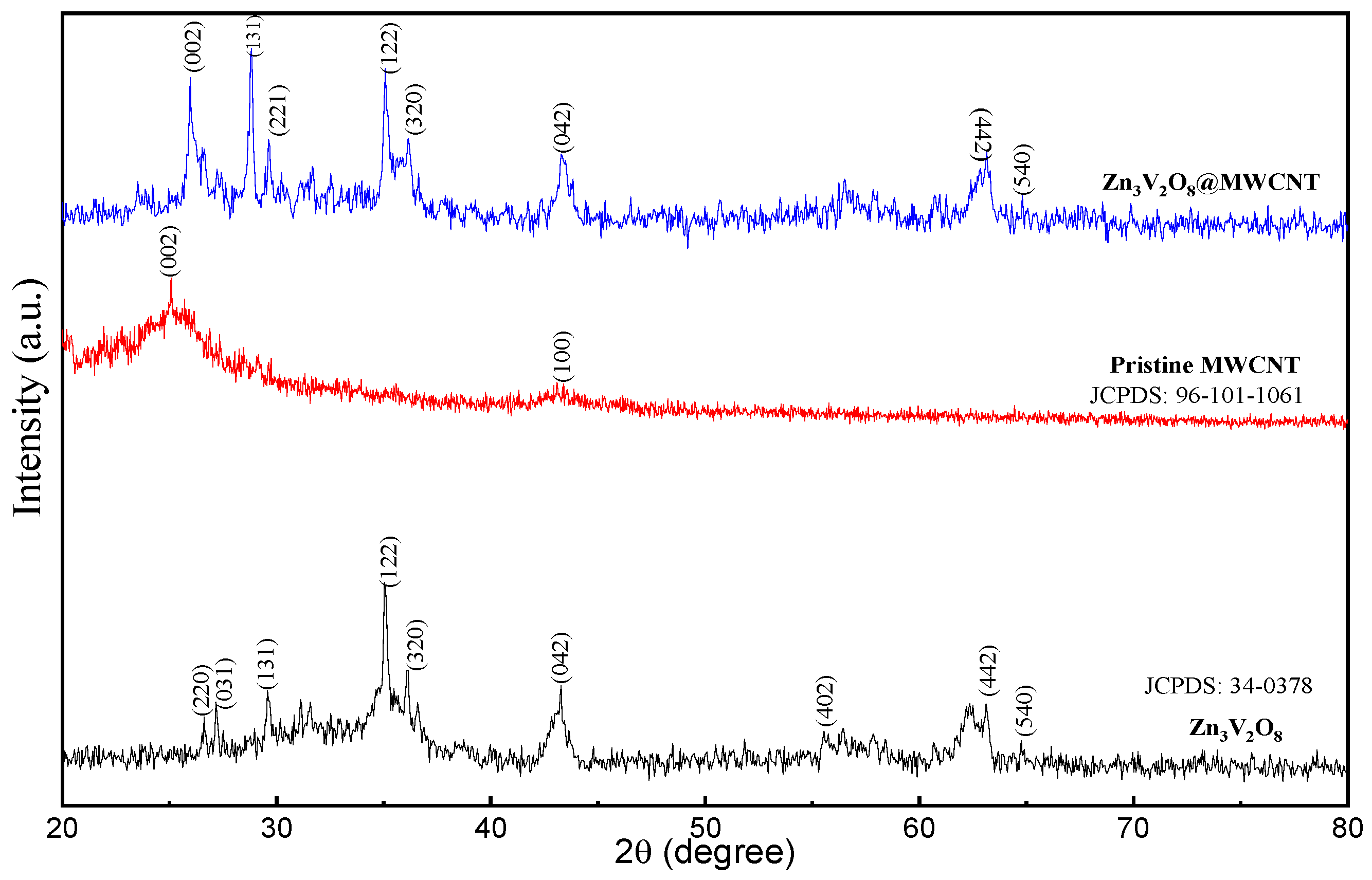

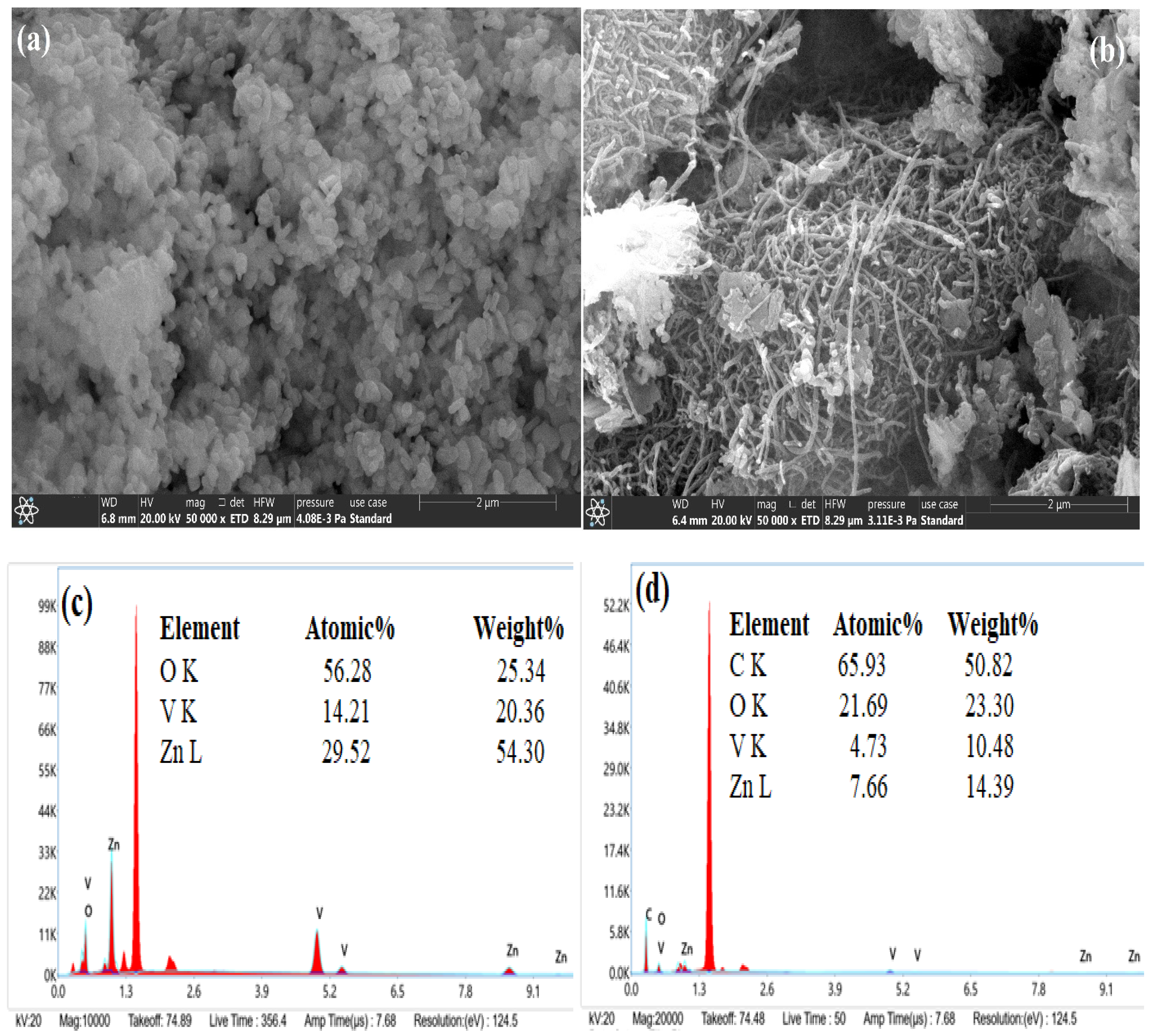



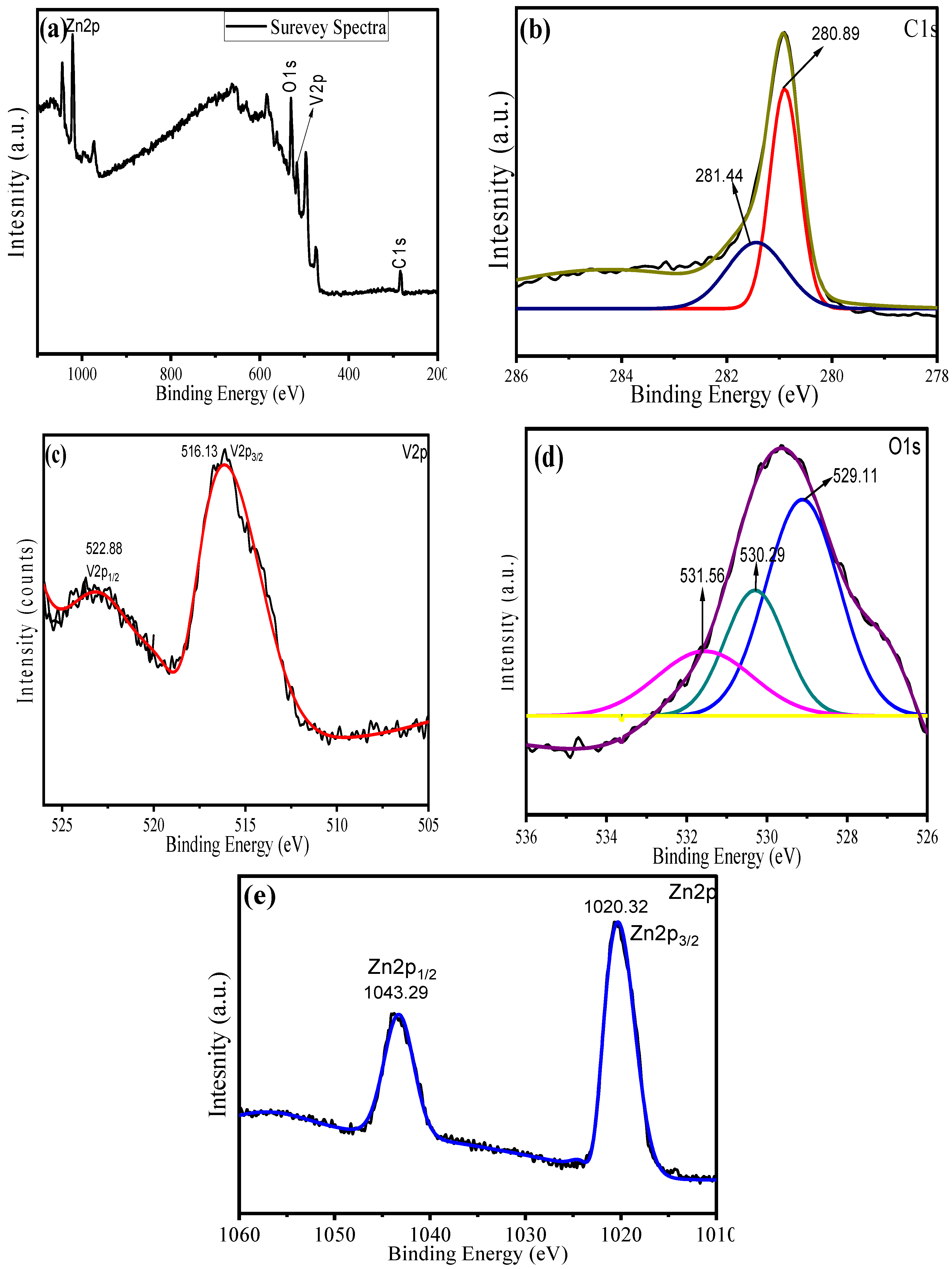
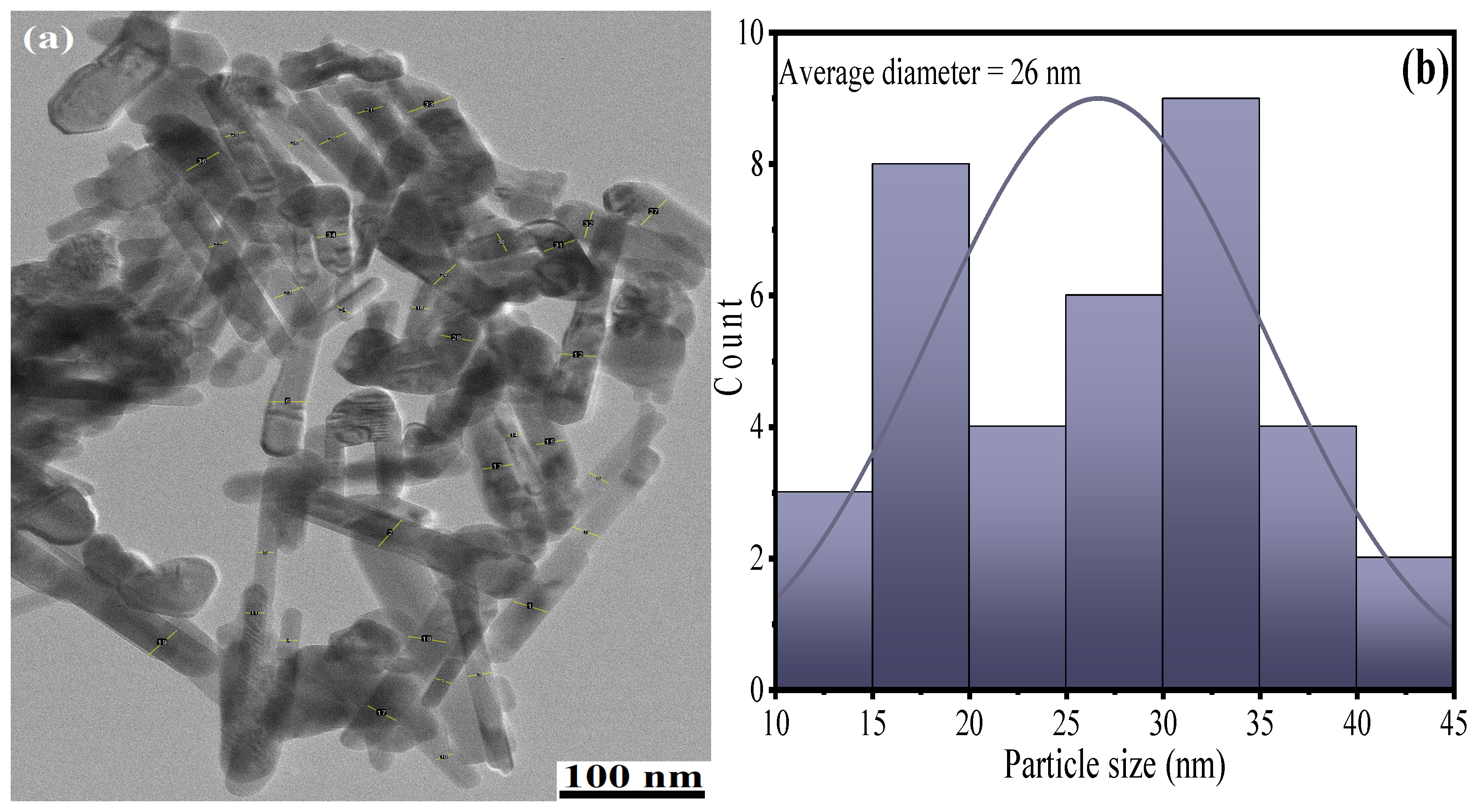
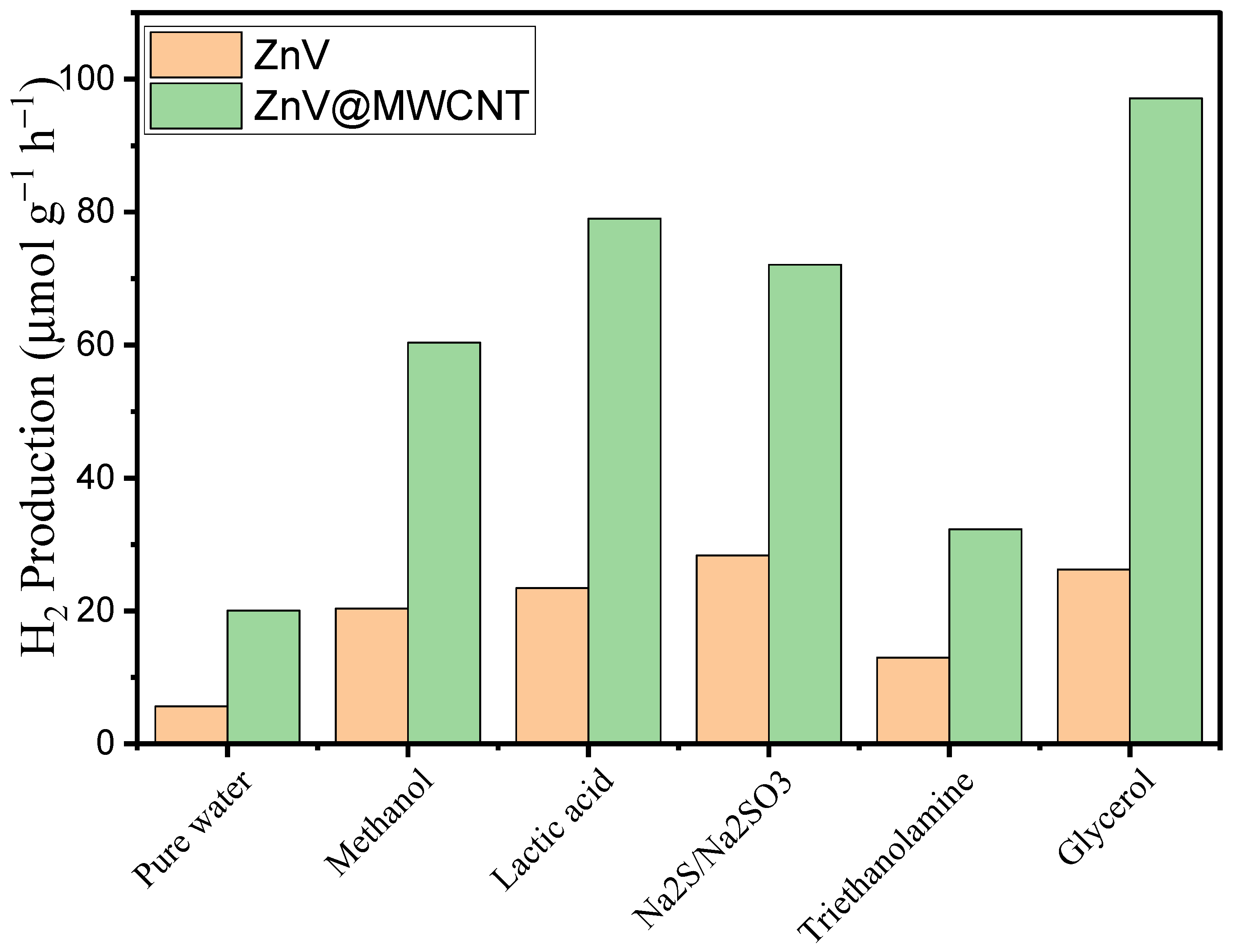

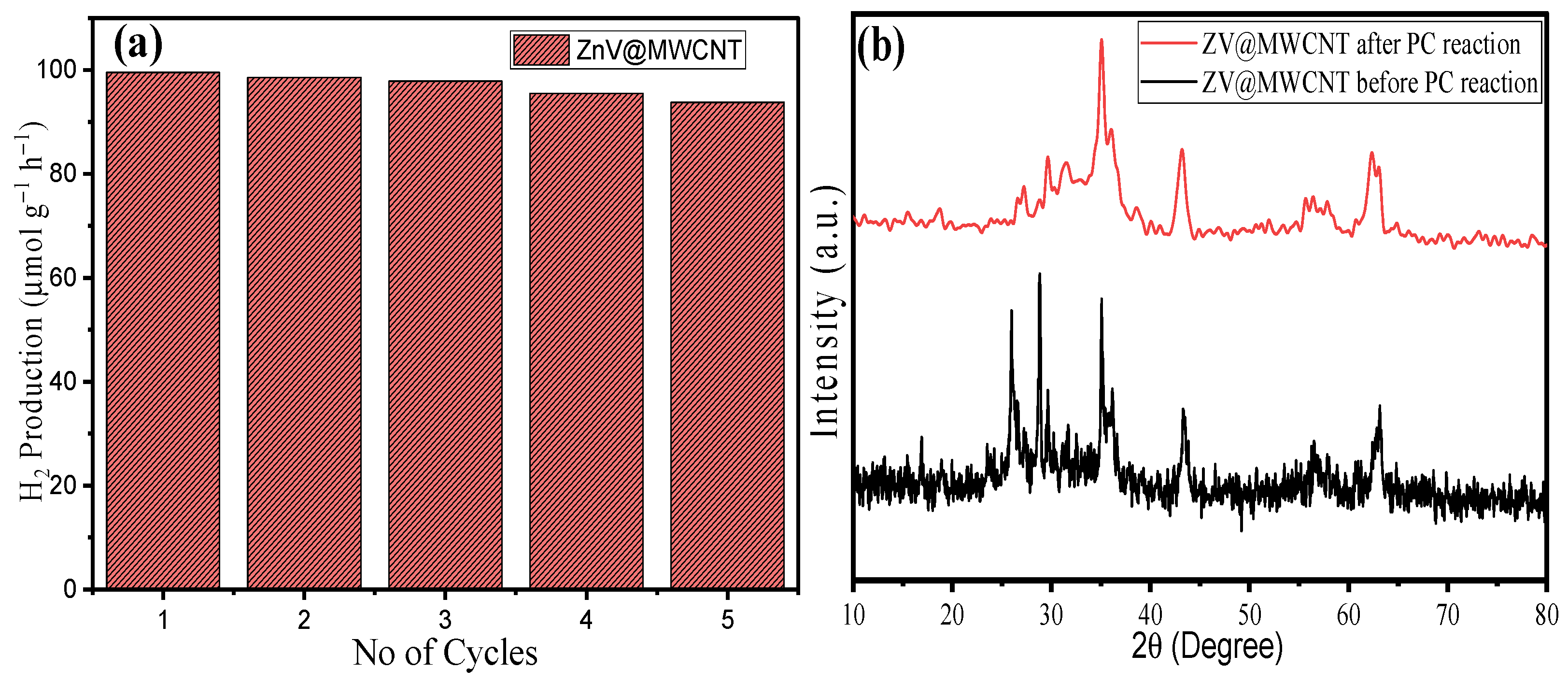
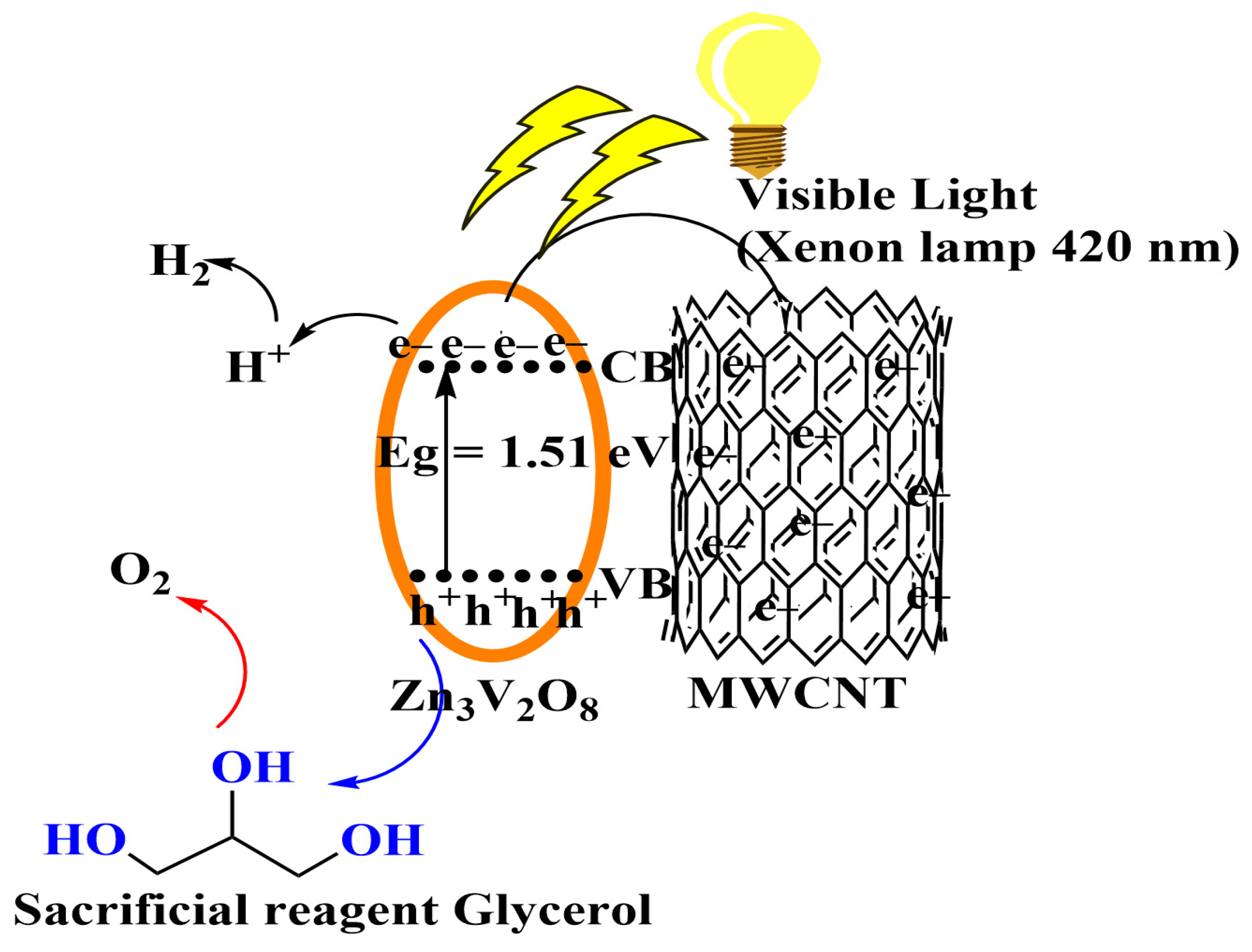
Disclaimer/Publisher’s Note: The statements, opinions and data contained in all publications are solely those of the individual author(s) and contributor(s) and not of MDPI and/or the editor(s). MDPI and/or the editor(s) disclaim responsibility for any injury to people or property resulting from any ideas, methods, instructions or products referred to in the content. |
© 2023 by the authors. Licensee MDPI, Basel, Switzerland. This article is an open access article distributed under the terms and conditions of the Creative Commons Attribution (CC BY) license (https://creativecommons.org/licenses/by/4.0/).
Share and Cite
Alharthi, F.A.; Ababtain, A.S.; Alanazi, H.S.; Alshayiqi, A.A.; Hasan, I. Zinc Vanadate (Zn3V2O8) Immobilized Multiwall Carbon Nanotube (MWCNT) Heterojunction as an Efficient Photocatalyst for Visible Light Driven Hydrogen Production. Molecules 2023, 28, 1362. https://doi.org/10.3390/molecules28031362
Alharthi FA, Ababtain AS, Alanazi HS, Alshayiqi AA, Hasan I. Zinc Vanadate (Zn3V2O8) Immobilized Multiwall Carbon Nanotube (MWCNT) Heterojunction as an Efficient Photocatalyst for Visible Light Driven Hydrogen Production. Molecules. 2023; 28(3):1362. https://doi.org/10.3390/molecules28031362
Chicago/Turabian StyleAlharthi, Fahad A., Alanood Sulaiman Ababtain, Hamdah S. Alanazi, Alanoud Abdullah Alshayiqi, and Imran Hasan. 2023. "Zinc Vanadate (Zn3V2O8) Immobilized Multiwall Carbon Nanotube (MWCNT) Heterojunction as an Efficient Photocatalyst for Visible Light Driven Hydrogen Production" Molecules 28, no. 3: 1362. https://doi.org/10.3390/molecules28031362







